A Commentary on HRV, its usefulness, and the recent research. . .
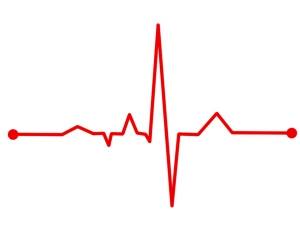
Normal heart signal
**Before diving in, a disclaimer — I truly intensely dislike the pissing matches that can sometimes devolve into nothing useful. My purpose in this article on the use of HRV to determine exercise performance is to examine the research, contribute my thoughts including reservations, and then provide you with more research to do more digging. I want to deliver solutions rather than kindling for more arguments.
With that said, here we go…
Heart rate variability (HRV) is gaining popularity now as a metric to investigate athletic performance, but is that its best use?
Is HRV the best thing ever or just another way to piss away your time with a new gadget?
Read on and find out…
Heart Rate Variability 101
HRV is a method to measure very small (fine scale) changes in heart rate (HR) to determine the status of the autonomic nervous system (ANS) (“Heart rate variability. Standards of measurement, physiological interpretation, and clinical use. Task Force of the European Society of Cardiology and the North American Society of Pacing and Electrophysiology,” 1996).
“A reduced HRV is associated with a poorer prognosis for a wide range of clinical conditions while, conversely, robust periodic changes in R–R interval are often a hallmark of health” (Billman, 2011).
A good primer on HRV can be found via the T-Nation Roundtable and a recent OPEX podcast I did.
The use of HRV in relation to exercise has been theorized for quite some time. HRV is gaining popularity now since it is noninvasive and now with smart phones, easy to do (Heathers, 2013, 2014; Quintana, Heathers, & Kemp, 2012).
“Exercise to begin with – and so long as it is practiced in moderation – renders the pulse vigorous large, quick, and frequent. Large amounts of exercise, which exceed the capacity of the individual, make it small, faint, quick and extremely frequent.” –Galen “The Pulse for Beginners” circa 131- 200 AD

Source: National Library of Medicine (the history of medicine public domain image files). Lithograph by Pierre Roche Vigneron (Paris: Lith de Gregoire et Deneux, ca. 1865).
Disclosure
Let me clearly state for the record that I am biased towards the intelligent use of HRV. I’ve conducted research on it starting over 12+ years ago; I use it with all my online athletes (and have for the past 6+ years); I created an entire education course on it, and companies / organizations hire me to consult directly with them on the use of HRV for athletes or even corporate wellness. I do make money directly from the use of HRV and, thus, will be biased towards its usefulness as a marker.
Having said that, I do try as hard as I can to take my biases out to the woodshed and beat the ever-living crap out of them to see if they are still valid. I am actively seeking to disprove my own pet hypothesis.
My current hypothesis is the “HRV Golden Rule” which states:
“HRV when done correctly will only tell you the status of the autonomic nervous system at that point in time.” – Mike T Nelson
While the ANS controls a ton of stuff in the body, it is only one part (albeit significant). It is also only a snapshot of the ANS at the time it was taken and anything beyond that is already an extrapolation. Having said that, it is still extremely usefully in my biased but humbly accurate opinion.
New HRV Study By De Oliveira et al. 2019
First off, kudos to the authors for getting this new HRV study published! I’ve done research on humans, and it is not an easy task. Research on higher / more elite athletes is even more rare. Everyone complains about the lack of data in high-level athletes, yet wants to armchair quarterback the latest study in elite humans for all sorts of goofball reasons.
My point of this article is to provide a take-away summary for people interested in how to use this data and not nitpick a study to death.
All studies have pros and cons. Many times by doing one thing, you cannot do another so you make a choice. I did a study looking at HR, HRV, and exercise with Monster Energy drink (Nelson, Biltz, & Dengel, 2014).
In the end, I used a time-to-exhaustion (TTE) measure – participant gets on a treadmill as I shove this device in her/his mouth to measure exhaled gases (metabolic cart), heart rate, RPE. RPE (rate of perceived exertion) is how hard you feel you are working . . .aka- keep going as hard as you can as I stand here and keep cranking up the treadmill intensity until you physically can’t go anymore. Such a mean experiment.
Critics state that TTE is not a good indicator of actual performance since nobody wins a marathon for being the most tired at the end. Since they win if they run faster than everyone else, a time trial (TT) should be used. For performance this thought process is 100% correct; the catch is that time trials when done in a lab with recreational (not elite) runners are highly susceptible to a learning effect (e.g they learn over multiple trials how to pace themselves better). If it turns out there was a massive learning effect, you just zeppelined your study. Oooops.
HRV Prediction of Performance
On the ole internetz, some in the fitness (hi there Menno) have posted why they dislike the use of HRV as it is poor at acute performance prediction. To which I say….. I agree!
Side note- in case you are wondering, Menno is someone I consider friend. Just wanted to make that clear before anyone starts lining up to throw potatoes my way.
I would counter though, that virtually nothing is good at predicting acute performance!
Set PRs On No Sleep
Have you ever dragged your sorry carcass to the gym after 4 hour of sleep and eating Pop-Tarts with a side of Jell-O only to find that you set a PR (personal record)?

Breakfast of champions?
While that is not the key to long-term success and surely does not happen every time, I will bet you an entire case of Pop-Tarts that it has happened to you a few times.
How odd- your fatigue was very high, yet you did better than ever before? What gives?
Hell, if I know, or if anyone really knows as we have barely scratched the surface of exercise fatigue.
I know of many elite-level powerlifters that will travel to an event, dehydrate themselves to make weight, sleep maybe a few hours the night before a big meet yet still set huge PRs.
What you may not hear is that they are wrecked for days to even weeks post. My buddy coach Phil Stevens calls it “the meet flu” where he will get sick post meet almost every time.
Great book on Fatigue
For clients, I explain it this way: I can redline my little 2001 4-cylinder Jetta and make it to the gym sooner; however, I can’t do that every day and expect the car to go 250,000 miles. There is a cost to running the engine so hard.
At a single measure, HRV is looking at the status of your autonomic nervous system, and we have data to see that it is very good at that function (dashboard for ANS).
What gets messy is how does the status of your ANS dictate performance?
Oh boy – can you buy me a Guinness, and we can debate highly theoretical ideas for the next 4 hours and yet still be in the same place?
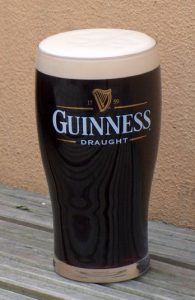
Buy me a Guinness.
The New HRV Performance Study
A few words on the study at hand entitled “Effect of individualized resistance training prescription with heart rate variability on individual muscle hypertrophy and strength responses” in the European journal of sport science by De Oliveira RM et al. 2019.
Pros
- They used high-level athletes
- Very intelligent design
- Huge amount of data, especially when you look at all the supplemental data
- The researchers were very familiar with training elite humans
- High-level journal- this was not in “The Journal of Highly Susceptible Results In Mice Paid by Big Industry”
Cons
- Short term study
- Breathing was not paced so it may have been an influence – this gets down in the weeds fast and there are pros and cons for the use of paced vs not paced breathing.
- A few other nitpicking things
Overall, it was a very well done, complete study on higher-level athletes- which is quite rare. Let’s break it down a bit more now.
HRV Study Design
51 total subjects were enrolled who were pretty darn good athletes judging by their VO2 peak and the requirements of the strength training program.
“The following inclusion criteria were used for the ST group: estimated one-repetition maximum (1RM) for a parallel squat of at least 80% of body mass for females and 120% of body mass for males and a minimum of 3 years of lower-body strength training with at least two strength training sessions per week.”
Table 1
Study Design
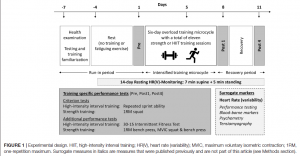
Training – Beat Me with a Stick
In short, they beat the piss out of the athletes via an AM and PM session over the course of 6 days, both in the HIIT (High-Intensity Intervals) group and the ST (Strength Training) groups.
Results
For HRV and resting heart rate (HR), check out the figure below that looked at changes as the athletes were laying downs (supine). What do you see?
Strength Training
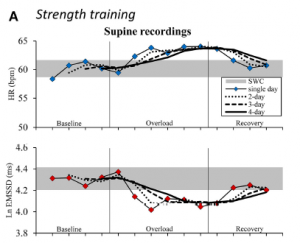
Interval Training
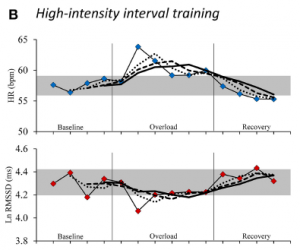
While this is a simplified view (see the study for the whole figures), I see that HR tended to go up in the overload phase and then reversed in the recovery phase. I see that HRV tended to go down (e.g. the athletes were more sympathetic /stressed) and then reversed in the recovery phase.
While the study did show that differences in the position when HRV was recorded mattered (standing vs laying down), don’t lose the forest for the trees.
HRV was good at looking at the amount of induced stress and the time course of ANS changes. This to me is the key use of HRV – How is your body responding to all stressors? Those stressors could be training, nutrition, sleep, etc. Not everyone is going to respond in the same way. By looking at the graphs above, you can see that HRV (and HR) did respond to the increased stress induced by the training program.
HRV is not the best predictor of acute performance, but that does not make it worthless. It is an accurate measure of ANS stress (Flatt, Esco, Nakamura, & Plews, 2017; Pereira, Flatt, Ramirez-Campillo, Loturco, & Nakamura, 2016; Shaffer & Ginsberg, 2017).
What you do with that as a coach is up to you. I personally use it now as a gauge on how hard to push my clients and when to pull back a little or add in more recovery.
HRV and Performance Summary
- We can split hairs and debate all the tiny details of the study at some other point over a few dark beers (and yes those details matter).
- HRV and HR did change in higher-level athletes in response to short-term overload via HIIT and strength training.
- The position of HRV collection (supine vs. standing) can be different if you are looking at interval-based training or strength training. More data needs to be collected on that before I feel comfortable making a recommendation. For now, most will be best served to collect HRV first thing in the AM in a seated position.
- HRV was not good at acute performance prediction, but nothing is good at acute performance prediction other than maybe another performance metric (e.g. vertical jump, bar velocity, etc.).
In the end, I still find HRV to be a useful tool when viewed as a marker of the athlete’s response to all stressors (training, nutrition, sleep, lifestyle, etc).
Pass me the pop-tarts.
Dr Mike
PS – If you would like to here me yammer further on HRV, check out the table below the references where I have some links to podcasts that I’ve done. HRV is not a simple answer and you can get more context by listening to them.
References
Billman, G. E. (2011). Heart rate variability – a historical perspective. Front Physiol, 2, 86. doi:10.3389/fphys.2011.00086
Flatt, A. A., Esco, M. R., Nakamura, F. Y., & Plews, D. J. (2017). Interpreting daily heart rate variability changes in collegiate female soccer players. J Sports Med Phys Fitness, 57(6), 907-915. doi:10.23736/s0022-4707.16.06322-2
De Oliveira RM, Ugrinowitsch C, Kingsley JD, Da Silva DG, Bittencourt D, Caruso FR, et al. Effect of individualized resistance training prescription with heart rate variability on individual muscle hypertrophy and strength responses. European journal of sport science. 2019;19(8):1092-100.
Heart rate variability. Standards of measurement, physiological interpretation, and clinical use. Task Force of the European Society of Cardiology and the North American Society of Pacing and Electrophysiology. (1996). Eur Heart J, 17(3), 354-381.
Heathers, J. A. (2013). Smartphone-enabled pulse rate variability: an alternative methodology for the collection of heart rate variability in psychophysiological research. Int J Psychophysiol, 89(3), 297-304. doi:10.1016/j.ijpsycho.2013.05.017
Heathers, J. A. (2014). Everything Hertz: methodological issues in short-term frequency-domain HRV. Front Physiol, 5, 177. doi:10.3389/fphys.2014.00177
Nelson, M. T., Biltz, G. R., & Dengel, D. R. (2014). Cardiovascular and ride time-to-exhaustion effects of an energy drink. J Int Soc Sports Nutr, 11(1), 2. doi:10.1186/1550-2783-11-2
Pereira, L. A., Flatt, A. A., Ramirez-Campillo, R., Loturco, I., & Nakamura, F. Y. (2016). Assessing Shortened Field-Based Heart-Rate-Variability-Data Acquisition in Team-Sport Athletes. Int J Sports Physiol Perform, 11(2), 154-158. doi:10.1123/ijspp.2015-0038
Quintana, D. S., Heathers, J. A., & Kemp, A. H. (2012). On the validity of using the Polar RS800 heart rate monitor for heart rate variability research. Eur J Appl Physiol, 112(12), 4179-4180. doi:10.1007/s00421-012-2453-2
Shaffer, F., & Ginsberg, J. P. (2017). An Overview of Heart Rate Variability Metrics and Norms. Front Public Health, 5, 258. doi:10.3389/fpubh.2017.00258
Podcasts on HRV |
| Complete Human Performance Podcast w Mike T Nelson, PhD |
| Carrick Institute talks w Dr Mike T Nelson |
| OPEX Podcast with Dr Mike T Nelson |
| 30 / 30 podcast |
| RTS – HRV & Fatigue |
| Nourish Balance Thrive Podcast w Dr Mike T Nelson |
| Dr. Mike T Nelson: Heart Rate Variability on Iraki Nutrition
|




Leave A Comment